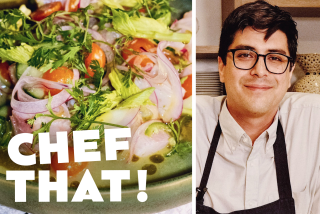Chives From China
One fine spring day in my favorite Chinese market, I rounded a corner and was surprised to find a crowd gathered at the far end of the produce section. People were snatching at bags filled with something yellow. I pushed my cart over there and grabbed the second-to-last bag. But what was it? Long, narrow ribbons gathered round and round, a wreath of daffodil-yellow. I caught a whiff of onion and garlic. When I asked a man next to me what they were, he pointed to sheaves of green Chinese chives and smiled. Then I connected: These other leaves had been blanched--deprived of sunlight, which forced them to produce that yellow hue.
While the flavor of most vegetables--asparagus, for instance--becomes more delicate after blanching, the taste of blanched Chinese chives is intensified. On the way home the car was filled with their perfume, a mouth-watering blend of chives and garlic with a soupcon of spring onion. The garlic part, by the way, accounts for one of their aliases, garlic chives.
That night I cut an abundance of chives into two handfuls of shortish ribbons. I heated long, thin Chinese egg noodles in boiling water (they come precooked). I stir-fried the chives in a dash, added the drained noodles and stir-fried everything furiously another 30 seconds, then crumbled over dried red chile for highlights and spunk. The ravishing two tints of gold and yin and yang flavors swept me away.
This was an herb I’d never grown. Quick! Out with the Asian seed catalogues!
*
I started a patch of Chinese chives from seeds that spring--if I’d known anyone growing them, I could have pulled a small bunch off an existing group and planted it. Like garden chives, Chinese chives are grown in clumps. It’s not one plant with a profusion of leaves, but a profusion of plants each with a few leaves. The leaves of Chinese chives are paper-thin and flat, like those of leeks, whereas the leaves of garden chives are hollow, like those of onions. This accounts for another Chinese chives alias, Chinese leeks.
Well cared for, Chinese chives can last 25 to 30 years. Leaves come up new-green in spring, then darken over summer. Exquisite in the border as an accent with other lilies (the onion family are lilies, remember), graceful clumps can reach eight or more inches in height, and flower stalks rise half again as high. These plants are not only uncommonly aesthetic but generous. Leaves never stop all season, and there are tasty buds and blossoms most of summer. When autumn’s air grows chilly, the plants disappear and are dormant through winter. In frost-free gardens, the plants may not last long, since they get no rest; grow them as annuals, starting fresh each spring. And if you haven’t a spot of earth for Chinese chives, grow them in a sunny spot in one- to two-gallon containers.
But what does “well cared for” mean?
In my garden, Chinese chives are raised without fuss. By now I have several clumps and have found any soil suits them so long as it’s well drained and rich in organic matter. Full sun is best, but half-day sun and bright shade the rest of the day is fine. On the whole, I water irregularly, but, as for any valued plants, I don’t scant on weeding.
*
Native to Southeast Asia, Chinese chives are among the nobility of any herbal venue. And, in Asia, the plants are raised with as much nurturing as the English lavish on cabbages grown for exhibition. Specific cultivars are grown for blanching, for flowers, and for green leaves. Plants are given time to become established--nothing is harvested the first year. Also during the first year, the soil is allowed to dry out thoroughly, then watered deeply. This sends the roots down deep after the water. Actually, it makes sense to pamper plants that produce so long and so generously.
The blanching process is especially weakening, but the technique is one of our garden adventures. In cold-winter climates, you can do it just once a year; where winters are warmish, you may be able to do it twice. Begin when the leaves are about six inches long. Give the group a crew cut, leaving an inch of stubble. Feed with liquid kelp (comes in a jug from the nursery) and immediately cover with a box that lets in air but not light. Give water at the base and lift the box only when you want to check conditions. When the leaves are the hue of a new harvest moon, snip them off at one inch and use at once. They quickly perish.
Now turn your attention to the buds and flowers coming along. The green-white buds are plump and tightly furled, sensuous garlicky morsels. Culture is the same as for Chinese chives grown for leaves, but limit each clump to four plants. The first year, nip out all thin flower stalks before they form buds. You can harvest buds the second year and thereafter. The buds swiftly open to a creamy pouf. New flowers are scented--imagine--like violets and roses. Once seeds have set, the garlic/onion returns.
What I’m crazy about in Chinese chive blossoms is the point when petals are still in place but the seeds are plumping. Composed of dozens of tiny florets, the puff is a blither of seeds, so the flower is crunchy. About this time, you start to worry about all those unripe tomatoes in the garden. Chinese chives could as easily be called Italian chives, since they’re garlicky. So I put the two together.
*
In a speck of olive oil and butter in a nonstick skillet, I saute whatever I have of seedy Chinese chives flowers and sliced green tomatoes (any size). After one minute, I throw on dry bread crumbs and saute, stirring, until the tomatoes are hot and softened and the crumbs nicely browned, about three more minutes. I serve this sprinkled with lemon juice and chopped green Chinese chives leaves, with bagels, cream cheese and lox for Sunday breakfast--or next to grilled chicken or fish for Sunday supper.
All this exotica doesn’t diminish the charm of the plant’s grassy green leaves. To me, they’re in a class with the leaves of shallots and green garlic--a clean refreshing flavor. You won’t find many recipes for them specifically, but it’s simple: When a dish calls for garden chives or green onions, try Chinese chives instead. To harvest, rather than snip off a bit here, a bit there, cut off whole leaves just above their base. This keeps the plant from looking as though it’s had a new-age haircut. In Asia, only full cuts are allowed--the whole plant snipped down to an inch--and only three cuts per season. If you choose to harvest this way, feed with kelp solution after each.
Sources
Fresh: At Asian markets, green Chinese chives are available the year around; blanched leaves come and go.
Mail Order: For green leaves, seeds of Nira (a Japanese alias) from Kitazawa Seed Co, 1111 Chapman St., San Jose, Calif. 95126.
For flowers, seeds of Chinese Leek Flower; for blanching, seeds and 2-year-old roots of Large Broad Leaf from Sunrise Enterprises, P.O. Box 1960, Chesterfield, Va. 23832.
* Thompson’s new books, “The Kitchen Garden” and “The Kitchen Garden Cookbook” (Bantam Books), are now in bookstores. Thompson can be reached via TimesLink e-mail at bubq86e. For information on TimesLink, call (800) 792-LINK, ext. 274.
More to Read
Eat your way across L.A.
Get our weekly Tasting Notes newsletter for reviews, news and more.
You may occasionally receive promotional content from the Los Angeles Times.










